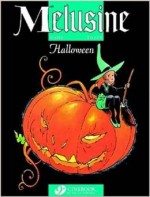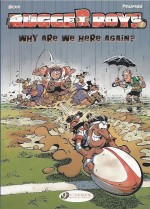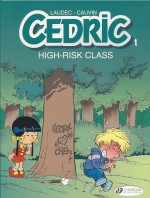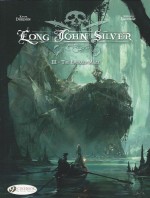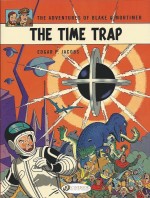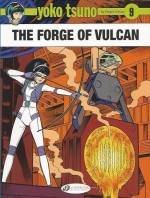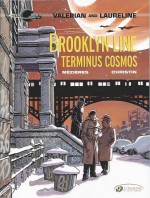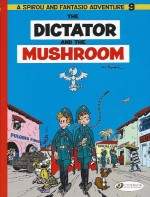
By André Franquin, translated by Jerome Saincantin (Cinebook)
ISBN: 978-1-84918-267-6
Win’s Christmas Gift Recommendation: Mirth and madcap melodrama in a true comics classic… 9/10
Spirou (which translates as both “squirrel†and “mischievous†in the Walloon language) was created by French cartoonist François Robert Velter using his pen-name Rob-Vel for Belgian publisher Éditions Dupuis in direct response to the phenomenal success of Hergé’s Tintin for rival outfit Casterman.
Thus, a soon-to-be legendary weekly comic entitled Spirou launched on April 21st 1938 with a rival red-headed lad as the lead of an anthology which bears his name to this day.
The eponymous lead character was originally a plucky bellboy/lift operator employed by the Moustique Hotel (a sly reference to the publisher’s premier periodical Le Moustique) whose improbable adventures with pet squirrel Spip gradually grew into high-flying, far-reaching and surreal comedy dramas.
Spirou and his chums have spearheaded the magazine for most of its life, with a phalanx of truly impressive creators carrying on Velter’s work, beginning with his wife Blanche “Davine†Dumoulin who took over the strip when her husband enlisted in 1939. She was assisted by Belgian artist Luc Lafnet until 1943 when Dupuis purchased all rights to the property, after which comic-strip prodigy Joseph Gillain (“Jijéâ€) took the helm.
In 1946 Jijé‘s assistant André Franquin assumed the creative reins, gradually sidelining the well-established short gag-like vignettes in favour of epic adventure serials, introducing a wide and engaging cast of regulars and eventually creating phenomenally popular magic animal the Marsupilami to the mix (first seen in Spirou et les héritiers in 1952 and eventually a spin-off star of screen, plush toy store, console games and albums in his own right). Franquin continued crafting increasingly fantastic tales and absorbing Spirou sagas until his resignation in 1969.
He was followed by Jean-Claude Fournier who updated the feature over the course of nine stirring adventures which tapped into the rebellious, relevant zeitgeist of the times with tales of environmental concern, nuclear energy, drug cartels and repressive regimes.
By the 1980s the series seemed outdated and without direction: three different creative teams alternated on the feature, until it was at last revitalised by Philippe Vandevelde – writing as Tome – and artist Jean-Richard Geurts AKA Janry, who adapted, referenced and in many ways returned to the beloved Franquin era.
Their sterling efforts revived the floundering feature’s fortunes and resulted in fourteen wonderful albums between 1984 and 1998. As the strip diversified into parallel strands (Spirou’s Childhood/Little Spirou and guest-creator Specials A Spirou Story By…) the team on the core feature were succeeded by Jean-David Morvan & José-Luis Munuera, and in 2010 Yoann & Vehlmann took over the never-ending procession of amazing adventures…
Cinebook have been publishing Spirou & Fantasio’s exploits since 2009, alternating between Tome & Janry’s superb reinterpretations of Franquin and earlier efforts from the great man himself.
André Franquin was born in Etterbeek, Belgium on January 3rd 1924. Drawing from an early age, the lad only began formal art training at École Saint-Luc in 1943 and when the war forced the school’s closure a year later, he found work at Compagnie Belge d’Animation in Brussels where he met Maurice de Bévère (AKA Lucky Luke creator “Morrisâ€), Pierre Culliford (Peyo, creator of The Smurfs) and Eddy Paape (Valhardi, Luc Orient).
In 1945 all but Peyo signed on with Dupuis and Franquin began his career as a jobbing cartoonist/illustrator, producing covers for Le Moustique and scouting magazine Plein Jeu. During those early days Franquin and Morris were being tutored by Jijé, who was the main illustrator at Spirou. He turned the youngsters and fellow neophyte Willy Maltaite AKA Will (Tif et Tondu, Isabelle, Le jardin des désirs) into a smooth creative bullpen known as the La bande des quatre or “Gang of Fourâ€.
They later reshaped and revolutionised Belgian comics with their prolific and engaging “Marcinelle school†style of graphic storytelling…
Jijé handed Franquin all responsibilities for the flagship strip part-way through Spirou et la maison préfabriquée, (Spirou #427, June 20th 1946) and he ran with it for two decades; enlarging the scope and horizons until it became purely his own. Almost every week fans would meet startling new characters such as comrade/rival Fantasio or crackpot inventor and Merlin of mushroom mechanics the Count of Champignac.
Spirou and Fantasio became globe-trotting journalists, travelling to exotic places, uncovering crimes, exploring the fantastic and clashing with a coterie of exotic arch-enemies such as Zorglub and Fantasio’s unsavoury cousin Zantafio.
Incidentally, The Dictator and the Mushroom features the second appearances of Zantafio and strong, capable, female (!) rival journalist Seccotine (renamed Cellophine for these English translations)…
In a splendid example of good practise, Franquin mentored his own band of apprentice cartoonists during the 1950s. These included Jean Roba (La Ribambelle, Boule et Bill), Jidéhem (Sophie, Starter, Gaston Lagaffe) and Greg (Bruno Brazil, Bernard Prince, Achille Talon, Zig et Puce), who all worked with him on Spirou et Fantasio over the years.
In 1955 contractual conflicts with Dupuis droved Franquin to sign up with rival outfit Casterman on Tintin. Here he collaborated with René Goscinny and old pal Peyo whilst creating the raucous gag strip Modeste et Pompon. Although he soon patched things up with Dupuis and returned to Spirou – subsequently co-creating Gaston Lagaffe in 1957 – Franquin was now contractually obliged to carry on his Tintin work too…
From 1959 on, co-writer Greg and background artist Jidéhem increasingly assisted Franquin but by 1969 the artist had reached his Spirou limit and resigned.
His later creations include fantasy series Isabelle, illustration sequence Monsters and bleak adult conceptual series Id̩es Noires, but his greatest creation Рand one he retained all rights to upon his departure Рis Marsupilami.
Franquin, plagued in later life by bouts of depression, passed away on January 5th 1997 but his legacy remains; a vast body of work which reshaped the landscape of European comics.
Originally serialised in Spirou #801-838, between 1953 and 1954 and subsequently released on the continent in 1956 as hardcover album Spirou et Fantasio 7 – Le Dictateur et Le Champignon, this epic episode begins as globe-trotting troubleshooter Spirou and his short-tempered pal Fantasio approach the isolated home of eccentric inventor Count Champignac, resolved to return the mischievous Marsupilami to its natural habitat in the jungles of Palombia…
Whilst they discuss their plan with the elderly savant, however, the mischievous monkey he’s been safeguarding has swiped the inventor’s latest mycoprotein marvel and headed for town…
Champignac calls the gaseous form of his newest mushroom extract “metalsoft†and that’s exactly what the stuff does: reduce the solidity of iron, brass, bronze, tin or whatever to the consistency of hot wax. By the time the prankish primate has finished innocently playing with the pump dispenser, the locals are in uproar and their village is practically a puddle…
With nobody in Europe objecting, the lads book passage on a South America-bound cruise ship, where once again the elastic-tailed terror causes a cacophony of comedic chaos. Eventually though, the increasingly irate and exhausted adventurers at last head in-country towards sleepy Palombia where a big surprise is waiting for them…
Thanks to Marsupilami, they are forced to travel the last ten miles to capital city Chiquito on foot and are astonished to observe the sheer number of military vehicles which constantly overtake them. In the city, an altercation with soldiers then leads to their arrest and interview with new supreme dictator General Zantas. The meeting is both a huge shock and unhappy reunion…
Fantasio’s cousin Zantafio had been only a little mean and perhaps misguided when they were all first hunting for the Marsupilami, but since then he has reinvented himself and graduated into a full-blown murderous megalomaniac: a cheap thug in a flashy uniform determined to carve himself a bloody empire and vast wealth through the conquest of his national neighbours.
Moreover, Zantafio/Zantas wants his countrymen to join him in the campaign of conquest, a horrific demand the reporters initially refuse.
Locked in jail, Spirou and Fantasio ponder how to stop the murderous scheme and realise the perfect counter to Zantas’ burgeoning war machine is Champignac’s Metalsoft. All they have to do is get a message to the inventor and have him send enough of the wonder stuff to destroy the ever-growing army…
Thus they apparently switch sides and are promptly installed as high ranking officers, but Zantafio is no fool and sets his most cunning spy to watch them; just waiting for the moment when they betray themselves.
Of course it’s not our heroes’ first rodeo either and, aware of their shadow, the lads engage in a prolonged and hilarious game of cat-&-mouse with the spook, all the while fretting that D-Day is approaching and still they have not been able to smuggle a message out…
A solution presents itself when go-getting journalist Cellophine makes contact. She’s been secretly covering the crisis for ages – without being caught like her mere male rivals – and offers to get the request for Metalsoft to Champignac ASAP…
Things aren’t all going Zantafio’s way. Even though weapons dealers are frantically auditioning their death-dealing wares for the General, Colonels Spirou and Fantasio are especially diligent and somehow able to find dangerous faults in everything on offer…
And then one night Cellophine sneaks back into Palombia with the secret weapon which will end Zantas’ dreams of empire…
Following a fantastical fight with the mushroom gas-wielding trio battling an entire modern military and a tense yet inconclusive showdown with Zantafio, peace and democracy breaks out and the boys finally complete their original mission.
Having at last safely returned the Marsupilami to his natural wilderness, Spirou and Fantasio wearily head back to civilisation, content in the knowledge that the lovable little perisher is back where he belongs.
Of course, the pestilential primate has his own ideas on the matter…
Stuffed with superb slapstick situations, riotous chases and gallons of gags, but barely concealing a strongly satirical anti-war message, this exuberant yarn is a joyous example of angst-free action, thrills and spills. Easily accessible to readers of all ages and drawn with beguiling style and seductively wholesome élan, this is another enduring comics treat from a long line of superb exploits, certain to be as much a household name as that other kid reporter and his dog…
Original edition © Dupuis, 1956 by Franquin. All rights reserved. English translation 2015 © Cinebook Ltd.
